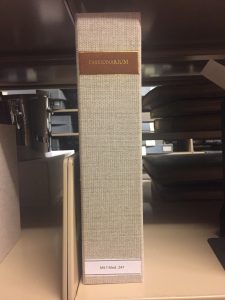Even though the Rare Books and Manuscripts department is closed to the public, we're bustling with activity behind the scenes! As we prepare for the upcoming major construction project which will help ensure the long-term preservation of our materials, we here at the conservation lab are all about boxes.
While we would love to build a specialized enclosure for each item, with around 240,000 books and over a million manuscripts, we would never have the time. Instead, our endeavors started months ago when conservators walked through the stacks with our curator and discussed solutions for our most vulnerable items.
First, we decided to identify aisles with the most need for special care. Based on factors like age, intellectual value, and provenance, our conservators flagged and measured items from within those aisles to receive manufactured phase boxes built to our specified dimensions. The company ships these boxes to us flat, and we assemble them. After a quality and fit check, we house items safely in their new enclosures and store them back on the shelf, ready for future safe handling.
The next step was to address items of an unusual nature. While we are primarily home to rare books and manuscripts, other rare artifacts have found their way into our collections over the years. In this case, nowhere needed our attention more than the “G.Cab boxes.” Items ranging from lead type forms to ceramic doll houses and from reproduction Grecian plates to a segment of wood from a tree in Charles Dickens’ garden were in boxes that, though once top of the line, were starting to break down from age and use.
We ordered large prefabricated archival boxes with trays and dividers, and our chief conservator sorted the items from the old boxes by size, shape, and weight. We gave each item its own padded compartment and carefully recorded each call number and location for future patrons.
Lastly, some of our most valuable items are getting the star treatment. For some collection items like medieval manuscripts and incunabula (the first printed books), we are building specialized drop-spine enclosures fitted precisely to each item, often padded with archival foam or pressure lids to accommodate their unusual shapes and finished off with a leather label announcing the item’s title and call number in gold.
These are just some of the steps we are taking to insure the safety of our rare books and manuscripts here at the BPL so that our collections will be in the best quality and condition for our patrons for years to come.






Add a comment to: All About That Box